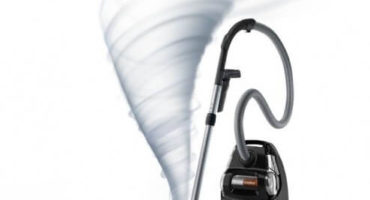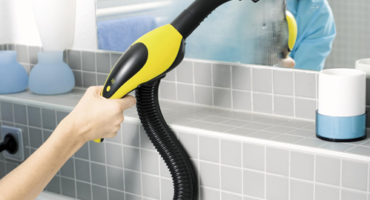For long service life of the pool it is necessary to regularly clean it. Just collecting rubbish from the surface of the water in an outdoor pool is not enough. It is necessary to carry out deep cleaning of the bottom and walls of the sides for the indoor pool at least once a week, for the pool in the open air it is necessary to carry out this procedure as it gets dirty, it happens that the need arises every day. It all depends on the number of people using this pond, and its location. For high-quality cleaning, it is best to use an underwater vacuum cleaner.

Vacuuming the pool
High-quality cleaning of the bottom and walls pool possible only with a vacuum cleaner. However, do not run into the house for an ordinary household vacuum cleaner. Here you need a specialized water vacuum cleaner. It will not only help remove dirt and deposits, but also make the water transparent and clean. It is not a shame to invite guests to such a pool and it is not scary to let children frolic in the water. There are several types of vacuum cleaners with which you can clean the pool.
Manual underwater vacuum cleaner - This is a brush that is connected by a hose to the filtration system. When the filtration unit is turned on, the water becomes purified and flows back to the pool.
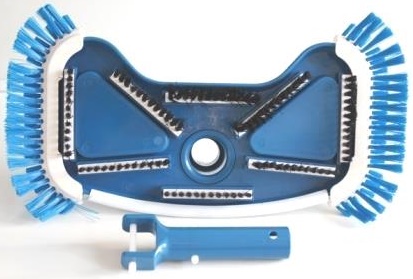
Fig. 1 Brush for a water vacuum cleaner
The device is simple and easy to use. Its equipment comprises a set of telescopic rods, hose and brushes of two types: the first is used to clean the bottom of the pool, the second is designed to destroy plaque on the walls.
There are also vacuum cleaners that can move along the bottom of a reservoir. They are called automated. Such devices can work in several modes, are very laborious and carry out not only water purification from dirt, but also its filtration.
Underwater Vacuum Cleaner
Receivers are of various types. The most convenient brushes in the form of a triangle having many bristles located in different directions. It is this design that allows you to clean the joints of the tiles on the bottom and walls of the pool, as well as pass corners well. But this option is not suitable for structures with an uneven bottom. For jacuzzi bowls, completely different nozzles are used, usually having a round shape.
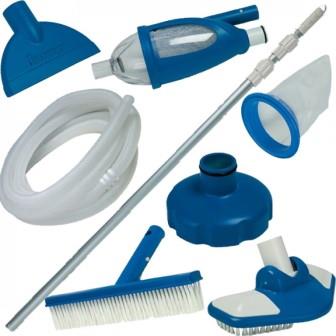
Fig. 2 Vacuum cleaner
As a rule, brushes and hoses for cleaning inflatable and prefabricated pools come with them and have an optimal length and shape for cleaning a particular pool. If you do not have such a kit, it can be purchased separately. Hoses for small models of ponds are sold in sections four meters long, each of which has a tip at the end, due to which several sections are easily connected together without the use of additional fasteners and mounting devices.

Fig. 3 Section of a vacuum cleaner hose
Cleaning the bottom is one of the most important steps in maintaining a pool. Especially if the pond is in the open. In this case, before using the apparatus, it is necessary to clean the surface and the bottom of the largest debris and dirt.
For large ponds, hoses are sold per meter, and for sports, they are wound onto special drums, because their length and weight are simply unbearable for one person.
Rods are both ordinary - consisting of a single piece of aluminum tube, and telescopic, their length can vary.

Fig. 4 telescopic rod
It is better not to save on the quality of the bar and not to take cheap Chinese options, they are very unreliable and short-lived, often they break during the first use. In addition, it is important that the rod has a clamping eccentric, if it is absent, the hose can detach from the rod and you will end up in the pool, unable to maintain balance.
Necessary measures before starting work
If there are several skimers in the pool where you are cleaning, they must be closed, leaving one, through which the whole process will be carried out. In large pools, flattening hoses can occur due to excessive pressure; care must be taken to prevent this from happening.
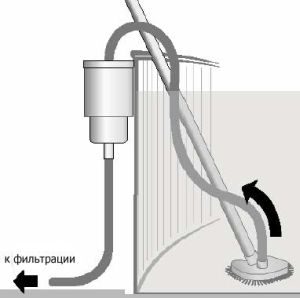
Fig. 5 Connecting a vacuum cleaner
Cleaning itself is a very time-consuming process and it is unlikely that you will be able to do this at a time. The larger the area being cleaned, the more times you will have to repeat this procedure. However, with proper use of the equipment, this number can be minimized as much as possible.
How is the cleaning process
A vacuum cleaner is placed near a skimmer or nozzle. One end of the hose fits onto the fitting. This must be done very carefully, taking into account that if the diameters do not match, the hose will either fly off during the process and all work will have to be started again, while still spending time waiting for the settling process of the turbidity raised as a result of such an incident to end. Or the hose may simply burst due to overpressure and the result will be the same. All work will have to start all over again.
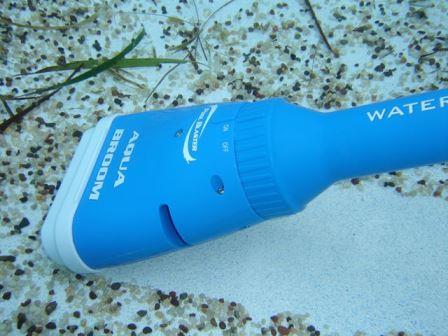
Fig. 6 Cleaning the bottom of the pool
To avoid such excesses, it is worthwhile to carefully select the dimensions of the hose and fitting and pay due attention to the very tension of the hose. If you are not sure of the strength of the fastener, it is worth using a stainless collar that will enhance compression.
Although in any case the appearance of a small precipitate is inevitable, the circular cleaning system will partially remove it. The rest will have to be cleaned by you, guiding again and again to the same places.
Next, lower the hose with a brush into the water and adjust the length of the hose to the size we need. It is advisable to fix the hose between the railing of the stairs, this will greatly simplify the work, as there will be no risk that it will slip out of your hands. Slowly flooding the hose from the side of the tube, we begin to draw water into it. It is very important at this stage to do everything right, because if air remains in the hose, air will clog the filter, and this can lead to equipment failure.
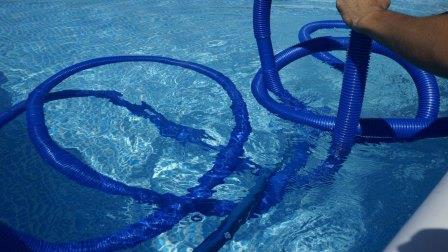
Fig. 7 Hose immersion in water
When the hose is full, we attach the second end to the vacuum cleaner and to the skimmer. Now you can start work. You need to move smoothly along a horizontal line, focusing on the boundaries of the tile. In the process of cleaning with a manual underwater vacuum cleaner, it is important to carry out movements from one edge of the bowl to the other. At the same time, drawing a conditional line on the tile, overlap the stripes. This will avoid missing areas.
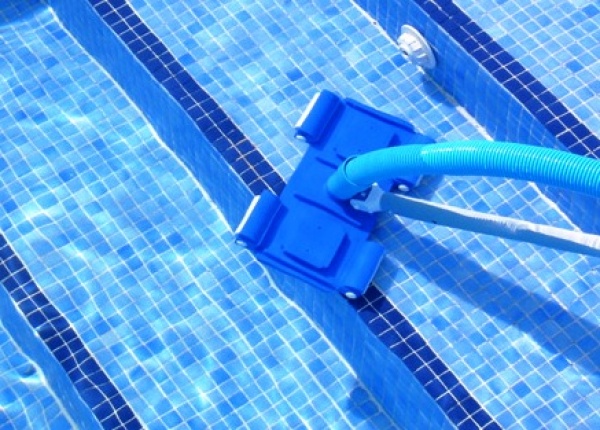
Fig. 8 Cleaning the bottom of the pool
Pool Vacuum Cleaner Safety
Do not forget about safety when working. It is very important to monitor the second end of the hose, because the larger the pool, the longer the hose is used to clean it, as a result of which the ceiling may be damaged or a window may be knocked out. And this is not only damage to the premises, but also the opportunity to get injured. Also, with excess heaping all the weight on the hose, you can be in the pool. Therefore, proceeding to such painstaking work, it is better to leave all the documents, papers, phones and other things somewhere else, you should not take them with you.
In addition, in no case should such work be carried out if there are people in the pool. Even nearby children are undesirable, as they can try to get into the water at any time.
Do not forget that cleaning should be carried out regularly, especially if it concerns open-air reservoirs.After all, they become polluted much faster and stronger, regardless of the number of people bathing. Leaves and other debris brought by the wind may get into them.
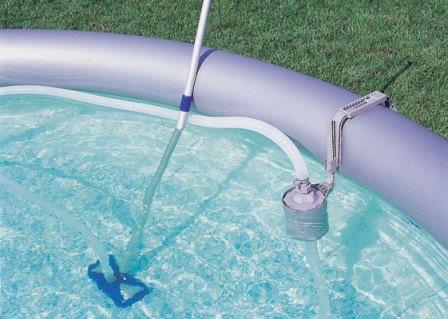
Fig. 9 Cleaning the inflatable pool
It also happens that such ponds are polluted by various children's toys, items from bathing suits and others. We don’t use a vacuum cleaner to clean such things, the pool bowl is cleaned of them with the help of a net or we just get it by hand. Your main task is to remove all large particles of garbage before starting a thorough cleaning, because they can simply clog the device and disable it.
The use of various types of vacuum cleaners
For sports and large swimming pools, as a rule, a manual type of vacuum cleaner is not used, it is very inconvenient and cumbersome. In such cases, another device is used - this is an automatic vacuum cleaner that does its work according to the plan.
In any case, after using the selected model of your assistant, you need to get rid of the remaining water and be sure to backwash his sand filter. It can then be folded and sent to a clean, dry place for storage until next use. It is advisable that there are no contaminants in the storage area that could affect the operation of the apparatus.

